I arrived back in Portland late Wednesday night and am trying to acclimate myself back to the city and figure out how to sum up the European trip I was on for the last month. I don’t think I’ll be able to put a neat little bow on it: my thoughts and feelings about everything I learned will come in waves as I get back to my real life. I’m sure I’ll reference my experience quite a bit in the next few months when the Portland Bureau of Transportation drops a new project plan or while waiting an inordinate amount of time for a TriMet bus to show up. (“They would never put up with this in Paris!”)
For now, though, I’ll do my best to draw some initial conclusions so I can pull myself out of Europe mode and get back to what’s happening on Portland’s streets. First, let’s get down to brass tacks about the bike infrastructure.
The quality of bike facilities varied widely between the cities I visited — I learned that the hard way when I took a Dutch/Danish approach to the more rough-and-tumble Parisian bike lanes — but I think there were lessons to be learned everywhere. Below are some that come to mind.
Grade separation is highly underrated
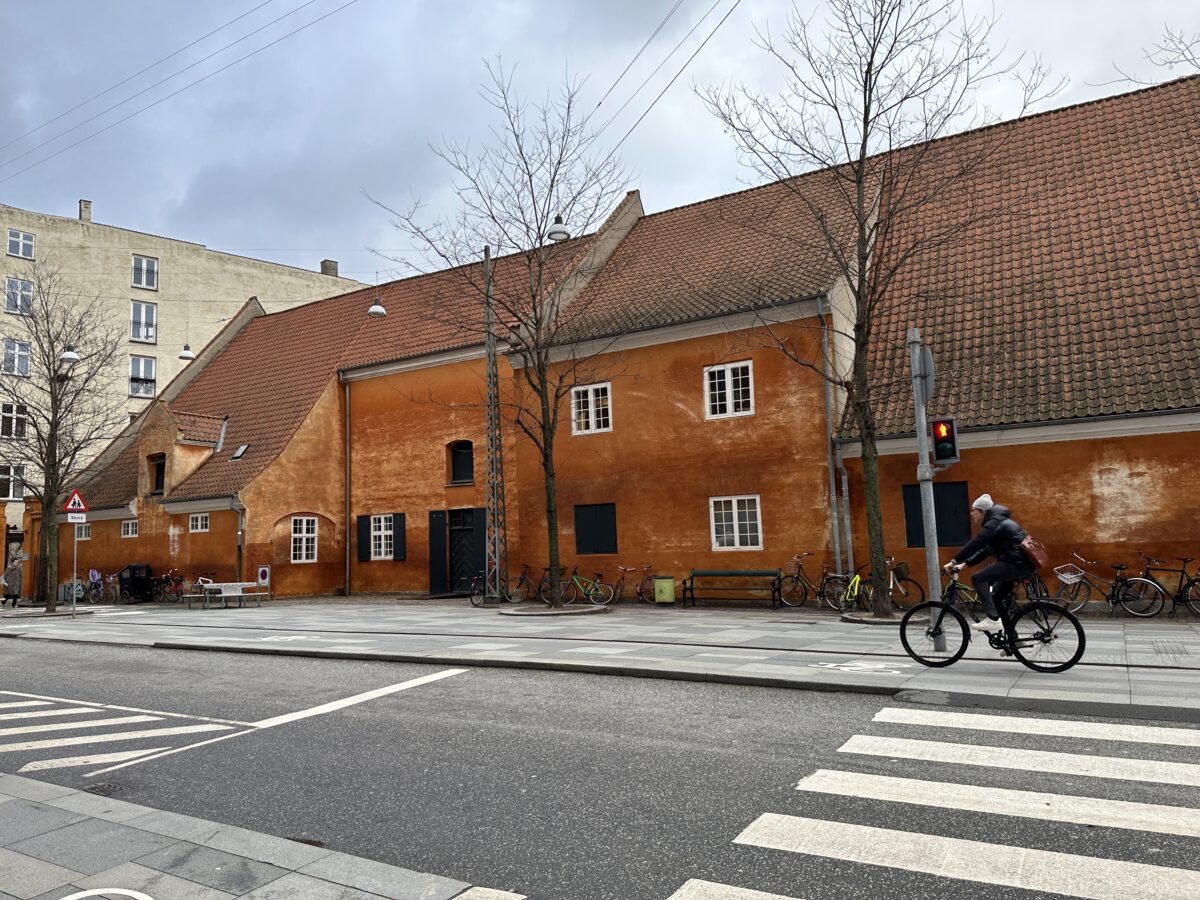

Even though I think I’m overall preferential to the vibes in Amsterdam compared to Copenhagen (or maybe Scandinavia in January is just too dark for me), there were some things about Copenhagen’s cycling infrastructure I thought were really ahead of the curve and made it feel just that much safer to bike in. This is mostly credited to the bike lanes that are on almost every street in the city, which are separated from car traffic not only with wide strips of curb and often a car parking lane, but also with elevation — a tactic I think is underutilized in Portland.
When a bike lane is separated from car traffic by a few inches of height, it adds just that extra bit of security for someone biking, especially if they’re traveling near high-volume and fast car traffic. It’s possible that safety is as much perceived as it is real, but feeling safe matters a lot for improving bike mode share and should not be overlooked. Copenhagen’s grade-separated bike lanes are also a few inches lower than the sidewalks, providing a distinction that helps combat conflict between people walking and biking.
I would like to see PBOT consider grade separation for new bike lane projects, which I think would really increase the appeal of plans like the newly-announced bikeway on NE Skidmore. The problem is that implementing this now would result in our bike network being more disjointed than it currently is, but that’s a trade-off I’d be willing to contend with.
Little things can go a long way



I understand the problems PBOT deals with when trying to improve our city’s bike infrastructure, and am willing to give them grace on many things: they’re up against a lot that’s out of their control. But there are some things the city could do right now to making biking better. And honestly, there’s no excuse for why we don’t have some of these.
One key example? Take the bike footrests or cycle rails I saw in Copenhagen. They give cyclists something to lean against while waiting at a red light. Copenhagenize.com‘s Mikael Colville-Andersen describes these as “a tiny detail. No bells and whistles, just a simple idea to make a tiny fraction of the day a little bit easier for a small percentage of the cycling citizens of the city. Which is precisely why it’s brilliant.”
Installing these rails at intersections with high bike traffic in Portland — like North Broadway and Williams, or Southeast Hawthorne and 11th, for instance — would not be difficult or expensive, and they would be much-appreciated. This is the kind of thing that would really take Portland up a notch as a world-class bike city.
Bike parking is a world of its own
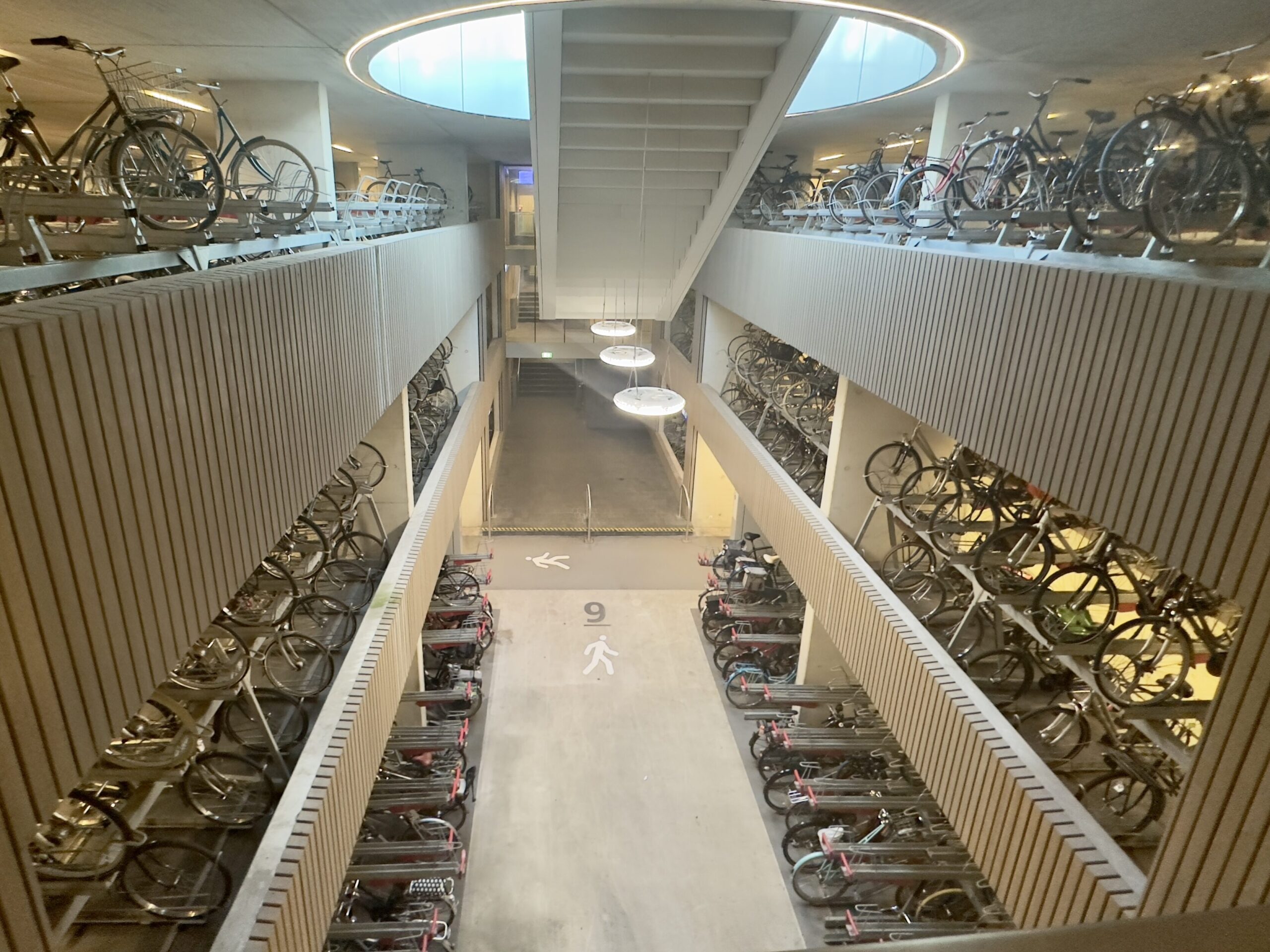

I have to be honest: I’m not sure that I really “get” the art of bike parking. It feels like an ecosystem that I haven’t quite been able to break into yet, and it’s also not something I’m typically that concerned about — but that might be because there are a lot of people on the case already so I don’t have to think about it.
Well, to those people I say thank you, because the bike parking iceberg goes deep, and providing nice bike parking facilities is a lot of work. I was struck by the enormity of the three-story bike parking garage in Utrecht, Holland — the biggest in the world — which offers 12,656 parking spaces and has digital signs alerting visitors how many spots are left. This is fantastic to me because it signals just how important biking is to the city’s residents and planners: the facility is right underneath the central train station and is much easier to access than car parking, indicating how Utrecht prioritizes transportation modes.
I stood on the top floor of the parking garage for a long time, watching people bike in and out in constant rotation, my mouth agape at the beauty of it all. After that, I started to notice bike parking a lot more, and I’m sure I’m going to maintain this energy going forward when I can’t find a spot outside Safeway even when there are dozens and dozens of empty car parking spaces. Thank you to the bike parking wonks, your work is highly appreciated and I will no longer take it for granted!
Maintenance absolutely must be prioritized


I know, I know, we never talk about it here on BikePortland, but PBOT has a maintenance issue. And considering maintenance staff are currently on strike and the bureau has a Sisyphean budget problem, it doesn’t seem like the issue is going to improve anytime soon. But it really, really needs to.
I was pretty relaxed about slipping and wiping out on black ice in Portland a couple months ago, but as I nurse my finger (which I seriously injured after I lost control on a big bike lane bump) back to health, I won’t be as calm about this going forward. What happened to me in Paris was a prime example of what happens when a city doesn’t pay close enough attention to the literal and proverbial cracks in the pavement, and it could’ve been a lot worse. Portland’s bike lanes have these same hazards and more. This needs to be a top priority.
Bike share systems are complicated
Portland’s Biketown gets its fair share of heat from advocates, particularly for a lacking inventory that forces people to walk long distances out of the way to rent a functioning bike. But as I attempted to rent bikes across Europe, I’m not sure I can say I came across a system that jumped out to me as a model we should emulate.
Many cities I visited have municipal bike share systems for city residents which seem to function very well. But these require jumping through some hoops and are inaccessible to people visiting. When I just wanted to rent a bike for a short trip, I used services like Bolt and Lime, which are expensive and sometimes just as inconvenient as getting a Biketown during peak hours.
Biketown could be better. But this is a hard business to get right, especially in the U.S., where we are culturally unaccustomed to doing a lot of public resource sharing generally. And as far as other U.S. cities go, New York’s electric Citibikes are ridiculously expensive — and apparently very difficult to rent, as I was unable to find a working e-bike when I was there a month ago. I think this industry is going to evolve quite a bit in upcoming years, and I really hope Portland can be on the front lines of that movement, because a great bike share system is so important.
(Try your best to) stay away from mythologizing
A major lesson I learned during my trip is that uncritically worshiping European infrastructure is ultimately unhelpful to improving the facilities we have at home. Though I know I have sung the praises of some of what I saw, I tried to do it in a way that wasn’t too reverent — and it can be a hard line to walk. No city is perfect, but some have systems that are evidently working much better to produce good results. We can get there too.
When I was biking around Brussels with my sister Kylie, she said she felt safer biking in Portland. (She lived here over the summer and was subject to my biking influence.) This really surprised me at first because I am often critical of Portland’s biking facilities. But once I lowered my Europe-colored glasses, I was able to see flaws in these European cities, and I saw where Kylie was coming from.
I love Portland, and I love biking here. We have a lot of good things; but we need to be better. I think we need to be able to take inspiration from great things happening around the world without venerating these places to a ridiculous degree. Put another way, we might make faster progress here if we don’t get so distracted with what they have over there.


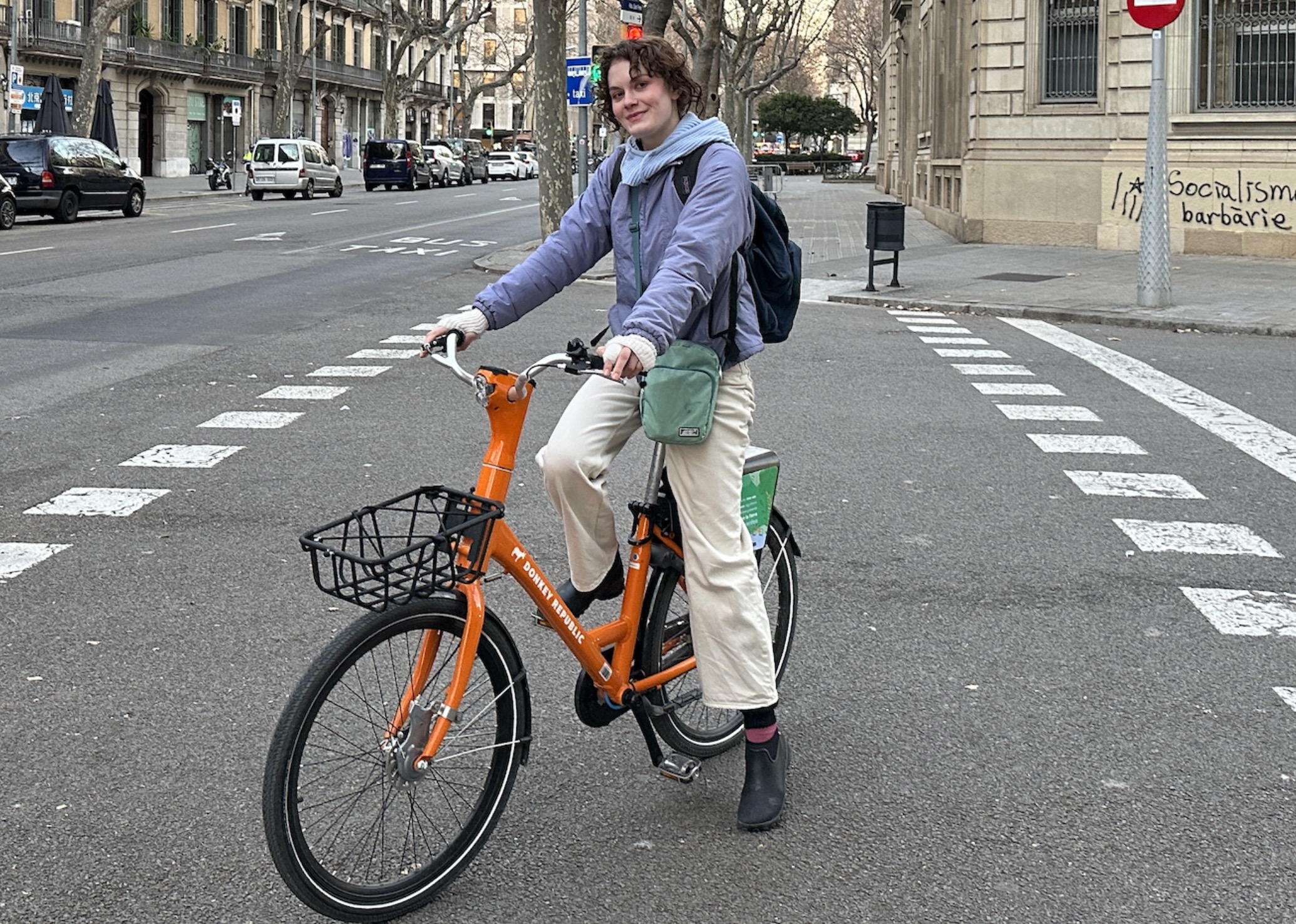

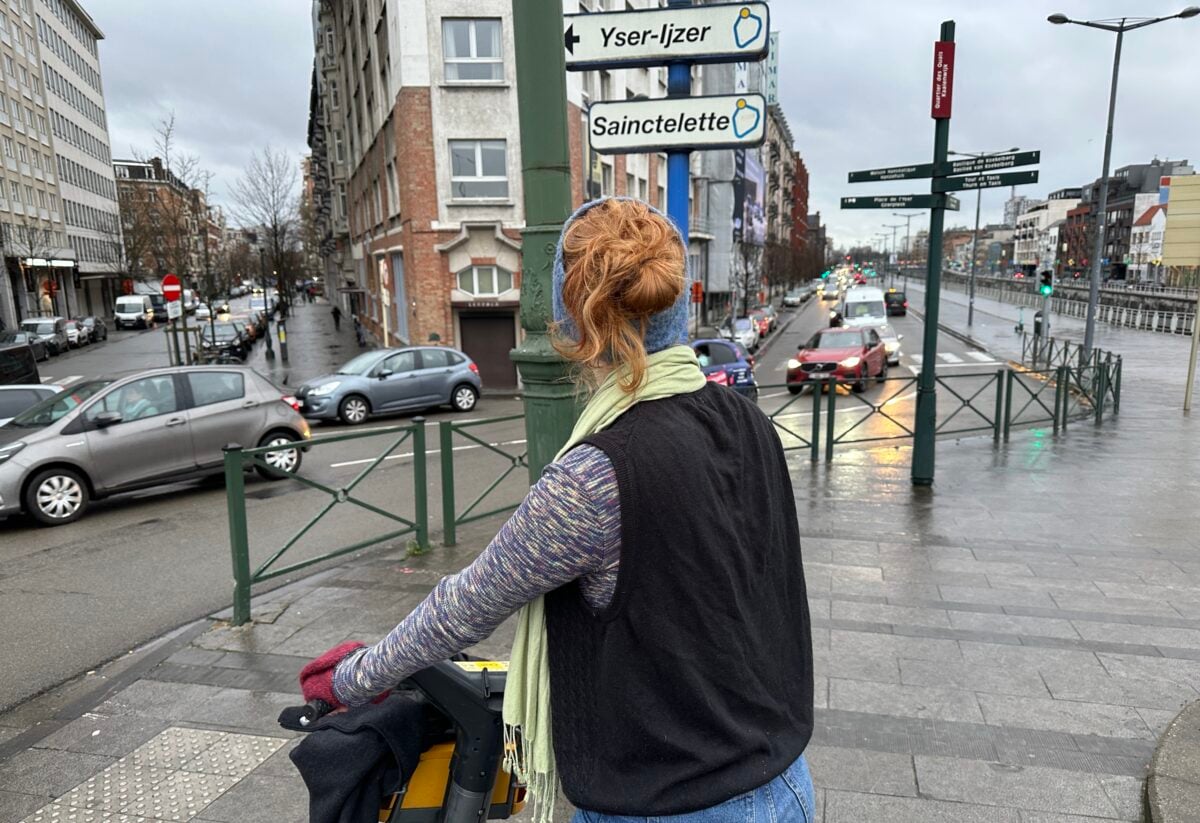
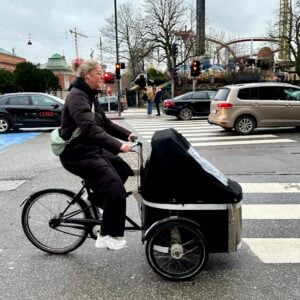
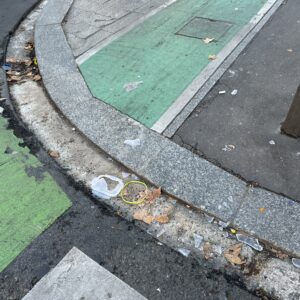


Thanks for reading.
BikePortland has served this community with independent community journalism since 2005. We rely on subscriptions from readers like you to survive. Your financial support is vital in keeping this valuable resource alive and well.
Please subscribe today to strengthen and expand our work.
There are a couple big issues with this type of grade separation that make it pretty rare in the US. First, having the bike lane be elevated from the roadway but below the sidewalk creates two curbs and thus two separate channels for stormwater to flow. So you now most likely need two separate sets of inlets and pipes. It all gets very expensive! I’m not sure how Copenhagen deals with that, maybe they just have a lot more money for transportation.
The other issue is ADA, which is not a thing in Europe but is the law of the land in the US. People with vision impairment often find this design to be less accessible and ADA rules discourage it. The preferred approach in the US is usually to have the bikeway fully at sidewalk level, with a strip of truncated domes or other detectable surface between the bikeway and pedestrian areas. You can also use a different surface type to distinguish them.
On that second point, something I’m always struck by when I go to Europe is that despite it often feeling like a pedestrian/bicycle paradise in some cities, they are way less accessible than most American cities. I would never want to be using a wheelchair in any major European city.
Hi Buster,
I wanted to share this photo my husband took in Paris, lets call it a compromise grade separation.
As you can see, the bike lane is slopped toward the sidewalk, which ends up creating a difference in elevation between the bike lane and its street and sidewalk curbs. As far as stormwater, he didn’t think you would need two separate channels, just an inlet with connector to the sidewalk pipe.
I totally disagree with your last paragraph, although I might have wholeheartedly agreed a few years ago. Americans should be proud of our AD and ID Education Acts. They were revolutionary. So yeah, pat ourselves on the back. But it’s not like the rest of the world has stood still.
This last trip to Europe in December, my walking wasn’t real good, so we rented a wheelchair. My experience is that Paris, and even Geneva, were much more accommodating of my disability than Portland. In all ways.
It’s a big topic, too much for a comment, but it seems obvious to me that having a strong public transportation network is crucial for accommodating disability. Next in importance, curb cuts. Sidewalks in Paris have them. There are a few curb cuts near my house in Portland, but no reason to use them much because my bus rarely runs.
Private residences are trickier, but hey, how many Portland houses have ramps? Most old (I mean hundreds of years old) Parisian apartment buildings have retrofitted small elevators into the center of their stairwells. Some elevators are the size of coffins, but others can fit a foldable wheelchair.
Then there are the cultural differences, I can’t do justice to them in a comment. Americans prize independence, they want frictionless accommodation. Parisians pride themselves on social skills and interaction. They will bring you a chair, walk you to the elevator in the next building over, offer you their seat, come running to your aid on the sidewalk, dash over to a bus that a vision-impaired stranger is exiting–all with kindness and a flourish. It’s what they live for, and also a much-used skill-set that goes along with living in a big city. Some of my most meaningful moments were in receiving help from a stranger.
Lisa, this is a wonderful comment, and thanks for bringing this up, Buster. I completely agree that Parisians are EXTREMELY helpful, and I totally dispel rumors of them being rude! I have some other thoughts about disability accessibility in Europe, maybe we can team up on a post about that 😉
Something I think we underrate in all of this is the role of culture and socializing. The reason I love biking is in no small part the social aspect of it. Riding with a friend, or having little interactions with pedestrians or other cyclists – it makes a commute properly enjoyable instead of a slog. This is something Portland has a history of doing well, and I think still does pretty well (despite the talks of a bike doomsday).
I’m from Madison, WI a great bike city on it’s own merits which honestly has better infrastructure in general than Portland. It helps that the city is smaller, but there are a handful of incredibly useful off-street paths which actually take you to most of the places you want to go. They are safe and convenient, and often the fastest way to get around the city (especially during rush hour).
But I’d still rate Portland as a better place to be a cyclist. I see lots of people out riding, and there are lots of high profile cycling events. People care about cycling a lot here, I mean I spend at least 25% of my workday perusing the comments section (which… I guess isn’t really a big bragging point but whatever). And I think it’s worth remembering that it’s not all about paths, pavement, and infrastructure. It’s about enjoying your time in the world, and riding a bike to get around makes my life a lot better!
Bike subculture that emphasizes youth-oriented social riding (often exclusionary) is a hallmark of cities where car culture dominates. These subcultures tend reinforce an us-vs-them dynamic that does little to undermine the dominant belief that transportation cycling is weird or unsafe (and especially so when many bike subcultural events involve unsafe behavior).
Sure, but you might notice that I mostly focused on the smaller interactions that make cycling enjoyable, and the passion people have for it here. I’m not really a “bike culture event attendee” type, but I still think it’s a positive for the city and the vibe. Seeing people on bikes makes me happy, it fills me with joy. I love riding, and I want people to see the world through the lens that my bike offers me.
If you want cycling to be “boring and normal”, you’re going to have to do quite a lot of work to break the hegemonic position of the car in American society. Good luck doing that without having a community (or subculture) to support you I guess.
Paris is a good example of a city where transformative changes were and are being implemented by a socialist-communist coalition government with little, if any, political support from a “bike subculture”. The graffiti in the first image in this piece is relevant to this point: “Socialisme o barbàrie”.
Right, and the list of major US cities that have ever elected socialist majors is like 5 maybe? Like sure, a socialist running in Portland would almost certainly have my vote but I do unfortunately live in the real world where US left wing parties have spent the last 100 years getting crushed or infighting.
The chances of a citizen led bike coalition pushing the right political buttons to enact change is like infinitely higher than a socialist-communist coalition emerging in even the most left-wing city in the country (which is not Portland for what it’s worth)
There is no citizen led bike coalition in Portland that pushes political buttons. All relevant orgs are top-down public benefit corporations with rigidly apolitical 501(c)(3) structures. However, it’s interesting that you are echoing the entire point of my reference to Paris — that political movements are far more effective at changing transportation systems than subcultures.
I don’t think social riding is necessarily youth oriented, at least not in Portland. Rather, most rides I’ve been on are very adult oriented. I’d argue that gen z makes up a smaller percentage of most Portland social rides. But I think that (subculture?) communities do tend to spring up as a safe haven for likeminded individuals with common experiences.
You should get a cuppa with soren, sometime.
Subcultures are like that.
We do have, I think, the best social bike culture in the world. One of my favorite things is running into a friend I haven’t seen in a while on a ride, stopping to have a chat. Or if you’re going to same direction, chat in motion! Try _that_ in a large motor vehicle. 🙂
Excellent insight, Taylor, thank you! Really enjoyed your reporting of your trip. Welcome home and glad your finger is on the mend.
I’ve rode bikes & studied public transportation in SE Asia, Europe, and more recently in Mexico City and always come home with both longing for things that could be done better & an appreciation for how good we have it here in the Portland (compared to the rest of the US).
I hope you’ve invited your new European biking contacts to visit us here (hopefully in the summer haha!) and we can continue to build a world wide coalition
Nice work, Taylor. I really enjoyed reading your reports from Europe. Take care of that hand.
Seconded! I very much appreciated getting to tag along in a fashion. I hope there are future opportunities to make similar explorations outside our local bubble. FWIW PT during and after healing helped me retain the use of my hand after a work injury and I cannot recommend it enough.
Welcome home Taylor!
And thank you for your gratitude to Bike Parking Wonks, I will accept it for my fellow unsung designers, fabricators, planners and operators in the USA. In my quarter of a century working in this space…Its a difficult space to commercially survive, even more so these days with the US shift to shared micro mobility: sandwiched between too few cyclists who wish to pay a retail fee for great secure parking, local governments not supporting a municipal service, and then there is the failure of congress in how it treats bikes vs cars in parking benefits. We know how to design, build and operate it, but just need the support.
I was just commenting to my fellow Bikestation alumni that the glory days of US bike hub parking may have been 2003 to 2008. (Pete and Joe you can fix this!!)
In Portland bike parking is mandated at privately built developments which results in some great things and some weird disfunctional fails.
Because I see it so often I’ll offer this example. At the Southwest corner of the US Bank Plaza building, AKA 555 SW Oak, are three staple racks set in the pavement. So, six spaces, right? The problem is that the placement of the racks allows at most four bikes to park, and if you consider passage for pedestrians maybe only one or two.
The private sector doesn’t always get things right, and a centrist, business-friendly city government isn’t a lot better.
Those foot rests at intersections are really luxurious! I never would’ve though it, but I experienced them in Santiago, Chile where they pair them with advertisements a la bus benches.
They’ve put them on the 2nd ave cycle track in Seattle, too!
Charlotte NC has several, all put in over the past 18 months or so.
Yes to bike lane foot rests!
What transportation US engineers (and planners) overlook is that footrests at traffic signals really help make transport cycling more accessible: weaker riders (older, etc.) can rest, youth riders growing into a ‘hand me down’ bike, riders with delivery cargo / groceries, or parents with wiggley kids in the back …experimenting with physics or boredom.
And it does not have to be that ‘bespoke’…just install multiple concrete wheel stops / old school pinned curbing.
They would be particularly helpful for coaster brake and fixed gear bikes
Thanks for the reports! I was in Utrecht for a year before they built the big bike parking facility, and it made me a much more frequent rider here.
Welcome back Taylor, it’s been exciting to travel along with you!
I like your point on grade separation. I suspect it would all but eliminate drivers “taking the bike lane” to jump traffic to the next corner as well. It requires some other concessions, like not putting parking on the other side of the bike lane, but that has upsides, too.
Good point about grade separation stopping cars from taking the bike lane, but if it’s a choice between NOT having any bike infrastructure and having grade separation, give me a plain old bike lane anyday. Also don’t forget the difficulty of building grade separation. Soon we’ll be able to ride on the grade separation of SW Capitol Hwy – over the ups and downs, dodging cars backing out of driveways and nosing into intersections. And it will have taken almost FOUR YEARS to build this grade separation. How much faster would it have been to slap in two bike lanes? Yes, I know moms feel better about their eight-year-olds on a separated path, but that’s about the only advantage I can see. Someone’s gonna get seriously hurt on the downhill path on Capitol Hwy – just wait for it. I’m taking the lane.
Nice reporting, enjoyed your articles.
Welcome back, Taylor! I enjoyed reading your stories, and I am jealous.
Thanks for your reporting from Europe, and especially this final summary article which was easy to skim and get great takeaways from the photos and headings. I especially appreciated the end – I do feel safer biking in Portland than many other places.
I love your amazing pictures and reporting!
I like the idea of grade separation, but from what I see motorists do around me in Reno, doing the noise cuts in the road on bike lanes, even in an intermittent pattern, would also perform a similar function: physically warn drivers away from using the bike lane space. They also have the advantage of being an off the shelf, right now functionality and would be less resource intensive and cost effective. A bridge measure between now, and any formally raised infrastructure…regardless, your later point is critical: active maintenance with dedicated staffing, not an assignment when other uses are done! Particularly in inclement weather. I.E., Utopia.
Sidewalk-level, i.e. grade-separated, bike lanes or “cycle tracks” are already PBOT’s preferred design for new construction/reconstruction (not retrofits): https://bikeportland.org/wp-content/uploads/2021/10/Portland-Protected-Bicycle-Lane-Design-Guide-v2021-050521-small.pdf
In my opinion these need to be continuous and paired with raised crosswalks to enhance ped & bike safety, and make street crossings more accessible to wheelchair users. Not Just Bikes has a good video about this: https://www.youtube.com/watch?v=9OfBpQgLXUc&t=209s&ab_channel=NotJustBikes
Thanks so much for your insights, Taylor!
Thanks Taylor for your reports from Europe.
Somewhere in my papers is my copy of the Dutch Bike Master Plan…or something to that affect, a multipage account of how The Netherlands came to be such a “bike heaven.” It was not just the way things had always been there; biking was declining in the 60’s, but the result of policy decisions at the highest levels of government.
In the 60’s The Netherlands was on a trajectory not unlike what was going on (and still goes on!) here…more roads, highways, fewer folks using bikes, etc. It was a pretty straightforward analysis of the fiscal and physical demands of a auto based transportation system that led to a sharp detour and a conscious decision to not build all the costly roadways that were envisioned and instead to emphasize less costly, more efficient transportation modes…transit, but especially bikes.
Et Voila, Amsterdam! et.al.